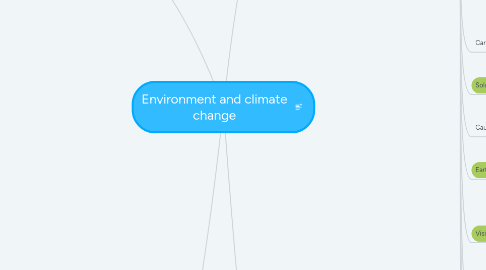
1. Module 2: Environment and life
1.1. Ecosystem
1.1.1. Factors affecting ecosystems
1.1.2. Ecological succession
1.1.3. Species Data Comparison Activity
1.1.4. Using Java applet for calculating average and standard deviation
1.2. Biomes
1.2.1. Types of biomes
1.2.1.1. Desert
1.2.1.2. Grassland
1.2.1.2.1. Savannah
1.2.1.2.2. Prairie
1.2.1.3. Deciduous Forest
1.2.1.4. Boreal Forest
1.2.1.5. Tundra
1.2.1.6. Aquatic
1.2.1.6.1. Freshwater
1.2.1.6.2. Marine
1.2.1.7. Rainforest
1.2.1.7.1. tropical
1.2.1.7.2. temperate
1.2.2. Biome Poster Activity
1.3. Components
1.3.1. Abiotic
1.3.1.1. Sunlight
1.3.1.2. Climate
1.3.1.3. Temperature
1.3.1.4. Precipitation
1.3.1.5. Elevation
1.3.1.6. Soil
1.3.1.7. Landforms
1.3.2. Biotic
1.3.2.1. Growth
1.3.2.2. Reproduction
1.3.2.3. Metabolism
1.3.2.4. Evolution
1.3.2.5. Response
1.3.2.6. Organisation
1.3.2.7. Homeostasis
1.4. Pollutants
1.4.1. Types of pollutants
1.4.1.1. Smog
1.4.1.1.1. Delhi smog
1.4.1.1.2. Great london smog
1.4.2. Climate Variability Disaster Activity
1.4.3. Types Of Pollution
1.4.3.1. Air
1.4.3.2. Water
1.4.3.3. Noise
1.4.3.4. Soil
1.4.3.5. Radioactive
1.4.3.6. Thermal
1.4.4. Biome and Pollution data analysis activity
1.5. Climatic adaptations and impact
1.5.1. Adaptations
1.5.2. Human survival and climate change
2. Module 4: Activity oriented learning and evaluation
2.1. Case study
2.1.1. Sustainability
2.1.2. Struggles
2.1.3. Campaigns by the company
2.1.4. Packaging and recycling
2.1.5. Water usage
2.2. Ipcc debate
2.2.1. Bhutan
2.2.1.1. favorable points
2.2.1.1.1. Tiny nation with less population
2.2.1.1.2. continuous decline of green house gas
2.2.1.1.3. supports worldwide convention on environment
2.2.1.1.4. carbon neutral country
2.2.1.1.5. 72% forest cover land
2.2.1.1.6. strong commitment for sustainability
2.2.1.1.7. maintaining carbon neutrality
2.2.1.2. unfavorable points
2.2.1.2.1. Less developed
2.2.1.2.2. needs large scale investment for low carbon transition
2.3. poster preparations
2.4. ways to help environment
2.4.1. Use renewable energy
2.4.2. recycle
2.4.3. save plants
2.4.4. save electricity
2.4.5. stop pollution
2.5. Google form survey and presentation
3. Module 1: Planet earth, its climate, and climate change
3.1. Atmosphere: blanket of gases covering Earth
3.1.1. Troposphere
3.1.2. Stratosphere
3.1.3. Mesosphere
3.1.4. Thermosphere
3.1.5. Ionosphere
3.1.6. Core
3.1.6.1. Inner Core
3.1.6.2. Outer Core
3.1.7. Exosphere
3.2. Structure of Earth
3.2.1. Crust
3.2.2. Mantle
3.2.2.1. Upper Mantle
3.2.2.2. Lower Mantle
3.3. Seeing vs Observing Activity
3.4. Global Temperatures
3.4.1. Analysis Methods
3.4.1.1. Ice Core
3.4.1.2. Satellite and Balloon
3.4.1.3. Dendrochronology
3.4.1.4. Sediment Core
3.5. Climate vs Weather
3.6. Climate Variability
3.6.1. Data collected through online simulations
3.6.2. El Niño Phenomenon
3.6.2.1. ENSO (El Niño Southern Oscillation)
3.6.2.2. Southwest Monsoon
3.6.3. La Niña Phenomenon
3.6.4. Trade Winds
3.6.4.1. Walker Circulation
3.6.4.2. Upwelling
3.6.4.3. Thermocline
3.6.5. IOD (Indian Ocean Dipole)
3.6.6. PDO (Pacific Decadal Oscillation)
3.6.7. Climate Change Factors
3.6.7.1. External causes
3.6.7.2. Internal causes
3.6.7.2.1. Anthropogenic
3.6.7.2.2. Natural
3.7. Temperature Variability and Profiling Activity
3.8. Ocean Acidification
3.8.1. Destruction of coral reefs
3.8.1.1. Coral reefs lose their alkalinity
3.8.2. Leads to ocean water warming
3.8.2.1. Releases water vapour and carbon dioxide
3.8.2.1.1. Causes fish to move to cooler places
3.8.3. Pumps
3.8.3.1. Solubility
3.8.3.2. Biological
3.9. Greenhouse Effect
3.9.1. Greenhouse Gases
3.9.1.1. Carbon Dioxide
3.9.1.2. Water Vapour
3.9.1.3. Methane
3.9.1.4. CFCs (Chloroflurocarbons)
3.9.1.5. Nitrous Oxide
3.9.1.6. Ozone
3.10. Carbon sequestration
3.10.1. Carbon sinks
3.11. Solar Insolation
3.11.1. Milankovich's Idea
3.11.1.1. Eccentricity
3.11.1.2. Tilt
3.11.1.3. Precession
3.12. Caused by pollution
3.13. Earth's Energy Budget
3.13.1. Positive
3.13.1.1. Induces global warming
3.13.2. Negative
3.13.2.1. Organisms and environmental stress
3.13.2.2. Leads to freezing
3.14. Visibility Spectrum
3.14.1. Ultraviolet Radiation
3.14.2. Can be human induced or natural
3.14.3. Infrared Radiation
3.15. Aerosols
3.15.1. Examples
3.15.1.1. Dust
3.15.1.2. Fog
3.15.1.3. Mist
3.15.1.4. Sulphate Aerosols
3.16. Cloud Condensation Nuclei
3.16.1. Examples
3.16.1.1. Sodium chloride
3.16.1.2. Ammonium sulphate
3.17. White reflects radiations, black absorbs radiations
3.18. Particulate matter
3.18.1. Examples
3.18.1.1. Liquid Droplets
3.18.1.2. Smoke
4. Module 3: Behavioural and technological solutions (renewable energy resources)
4.1. International agreements for climate change
4.1.1. India's INDC(2030 goals)
4.2. carbon credit
4.2.1. Tradable certificate for emission of CO2
4.3. Carbon trading
4.3.1. Buying and selling of carbon permits
4.3.2. Reduction in carbon emission
4.4. Individual carbon footprint
4.4.1. Usage at home,electricity
4.4.2. Cooking
4.4.3. Transportation
4.4.4. Usage at office/University
4.5. Limitations of carbon trading and credit
4.5.1. GHGs emission have increased
4.5.2. Monitoring by the government officials
4.5.3. Carbon credit market not developed in India
4.6. energy sources
4.6.1. Conventional
4.6.1.1. Renewable sources
4.6.1.1.1. solar
4.6.1.1.2. wind
4.6.1.1.3. Biomas
4.6.1.1.4. Geo-thermal
4.6.1.2. Non-renewable sources
4.6.1.2.1. Gas turbine/FC system
4.6.1.2.2. Coal
4.6.1.2.3. Oil
4.6.1.2.4. Natuaral gas
4.6.1.2.5. Hydropower
4.7. Hybrid system
4.7.1. Combines renewable energy with non-renewable/conventional
4.7.1.1. Wind/PV/fuel cell battery
4.7.1.2. Micro-turbine/fuel cell system
4.7.1.3. Micro-turbine/wind system
4.7.1.4. Hydro power/(wind-pv) system
4.7.1.5. Wind/FC system
4.8. behavioral changes
4.8.1. Action that results from thoughts and emotion
4.8.2. Change in behaviour to fight climate change
4.8.2.1. Changes found in behaviour at home
4.8.2.1.1. Saving energy
4.8.2.1.2. Avoid food wastage
4.8.2.1.3. Solar power ,solar thermal
4.8.2.1.4. Saving water
4.8.2.2. Changes found in behaviour during travel
4.8.2.2.1. Use of public transport
4.8.2.2.2. Switch off engine at signles
4.8.2.2.3. hybrid car,electric car

